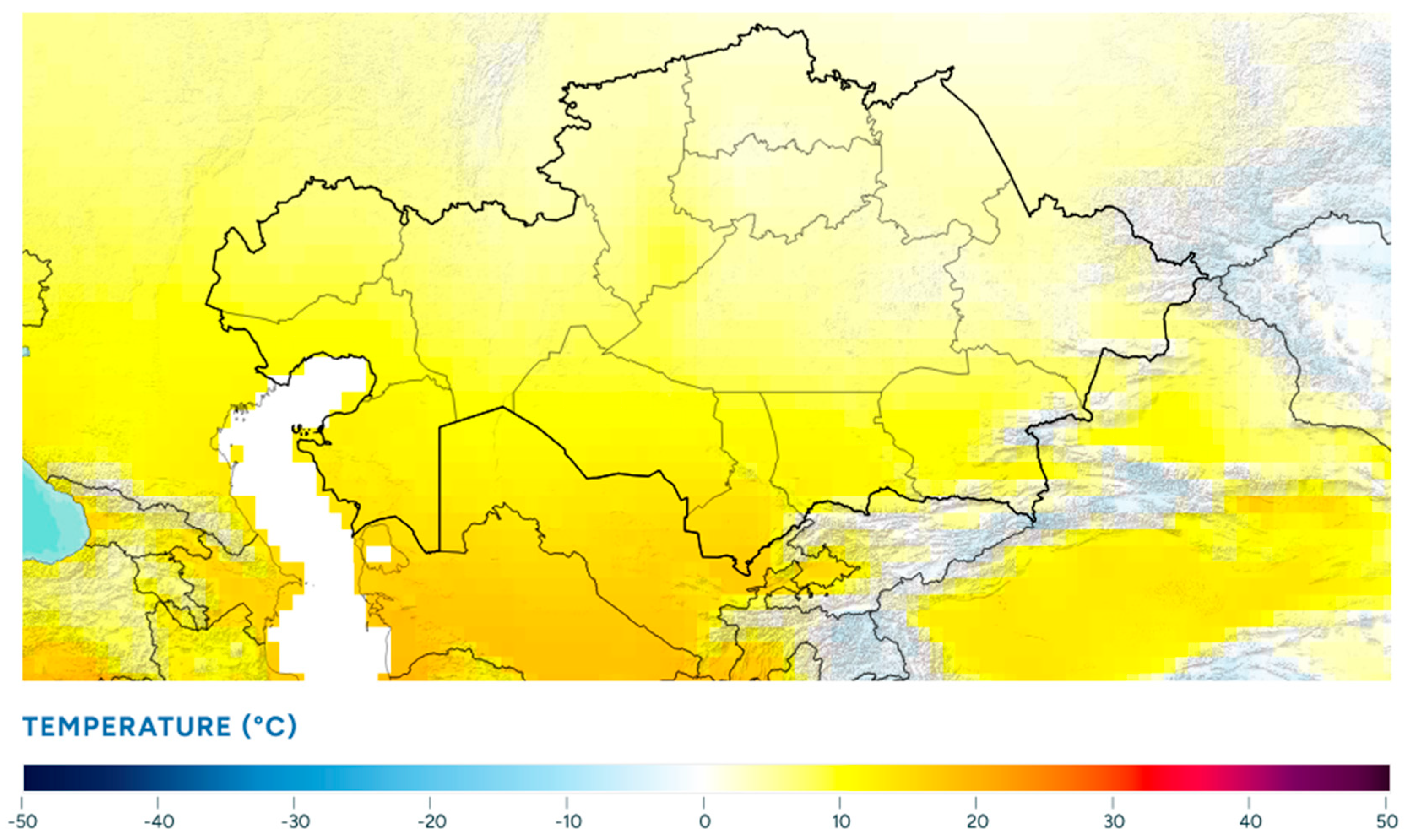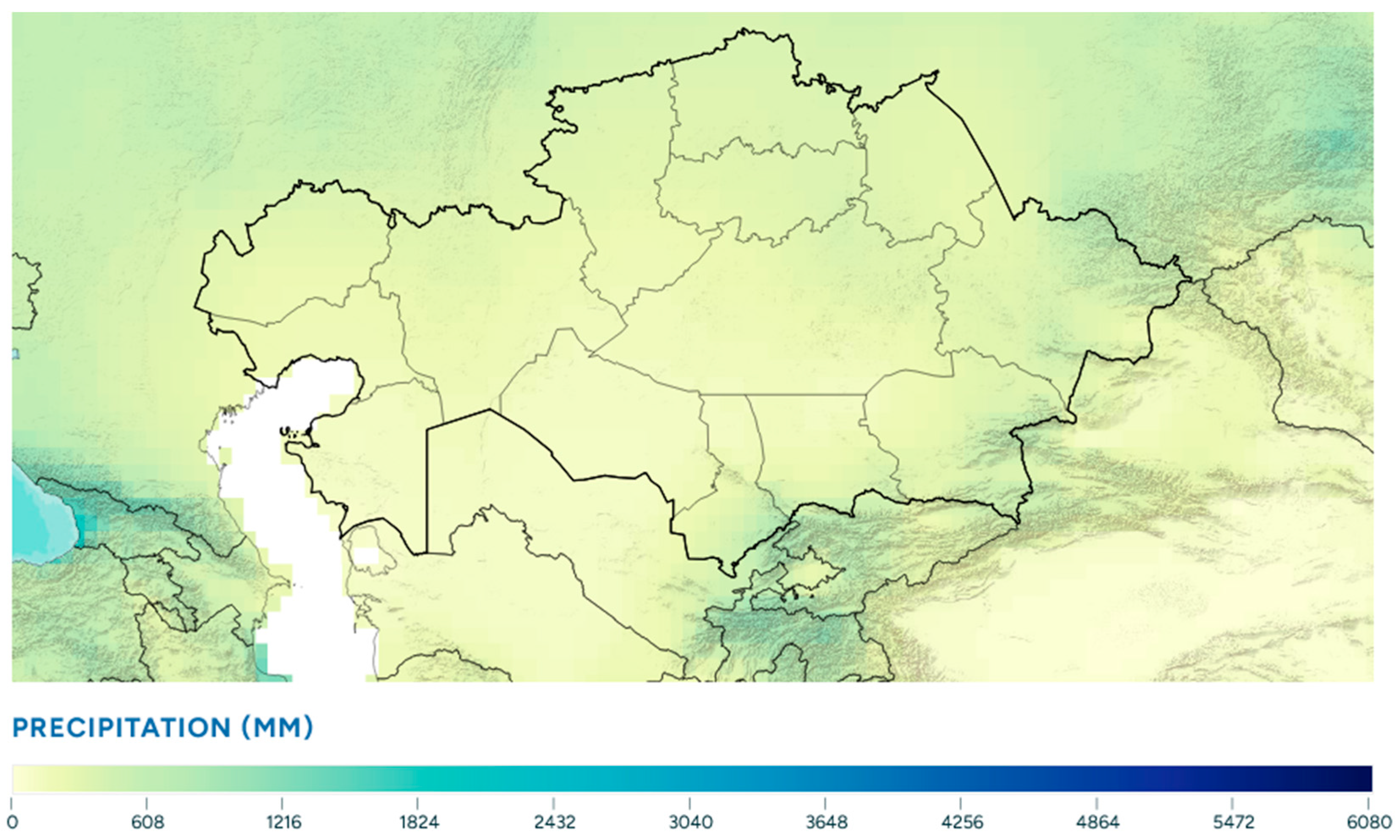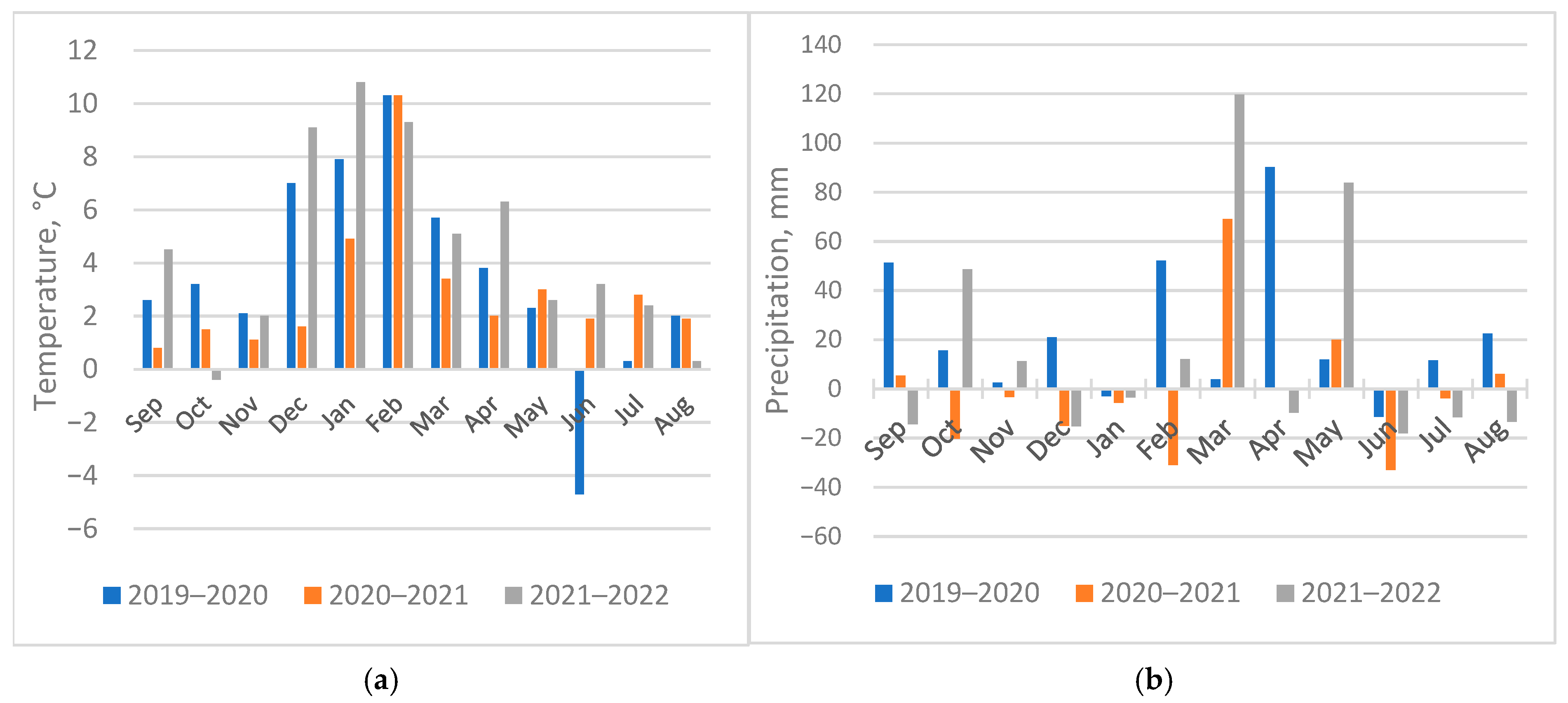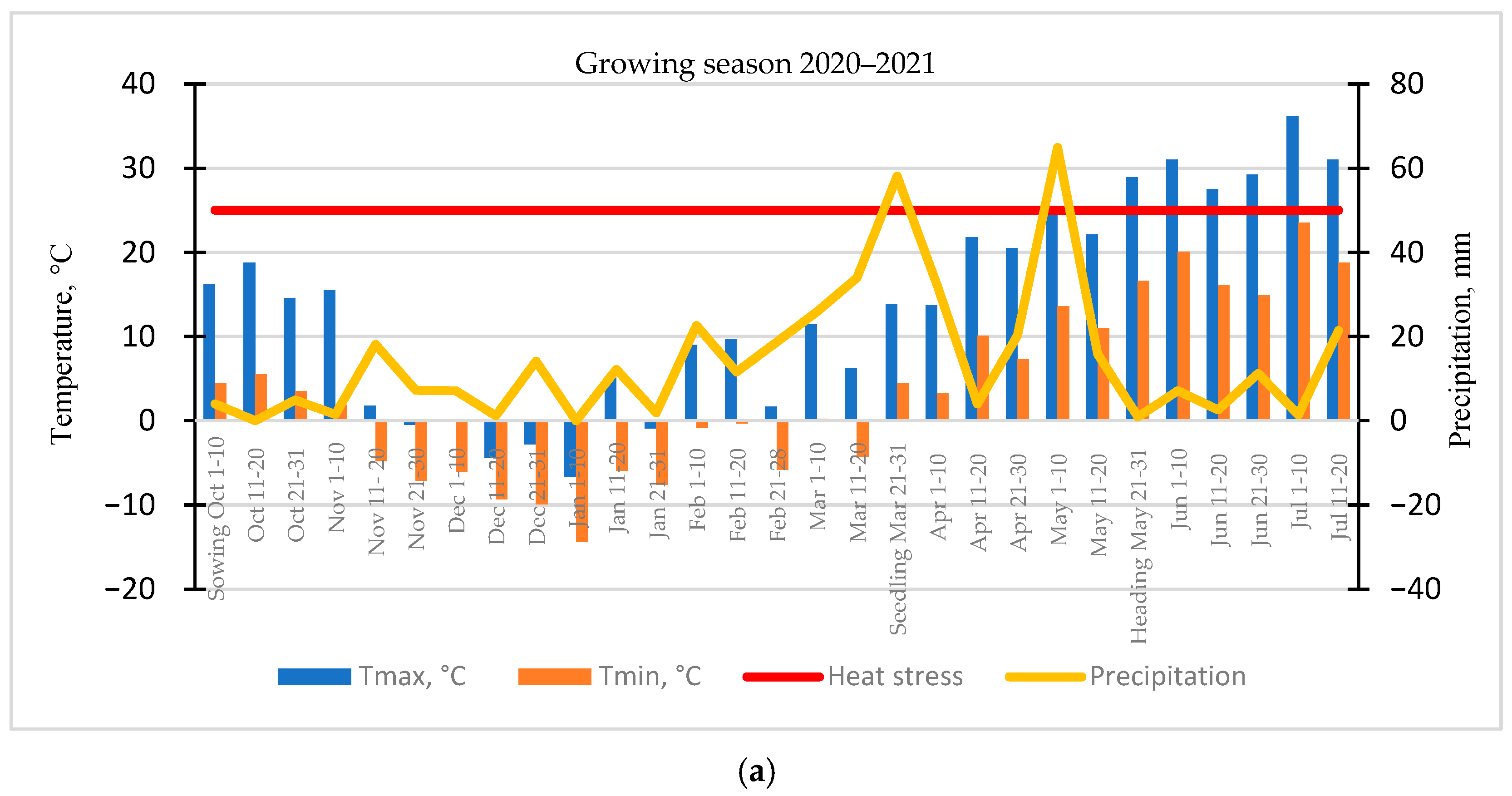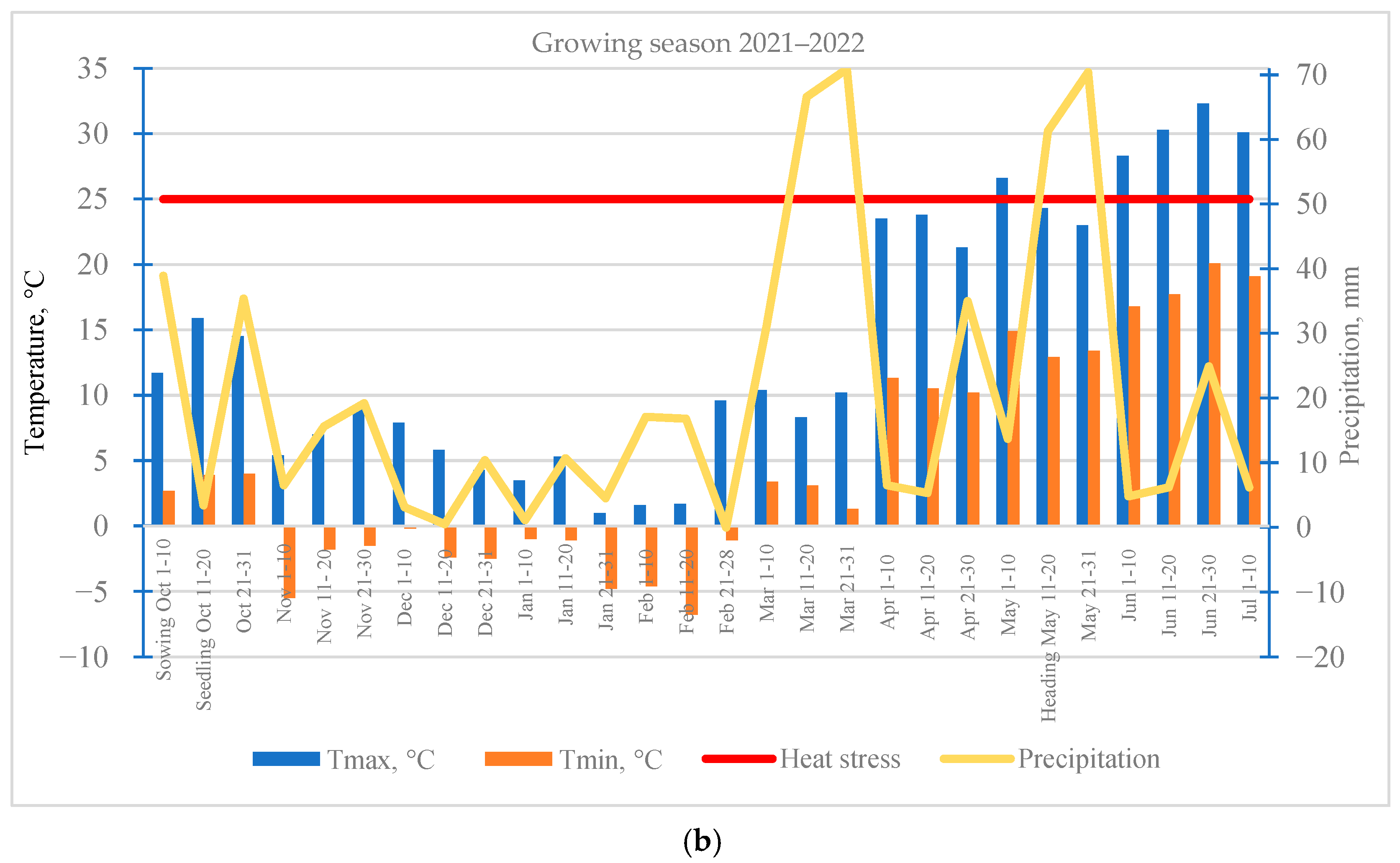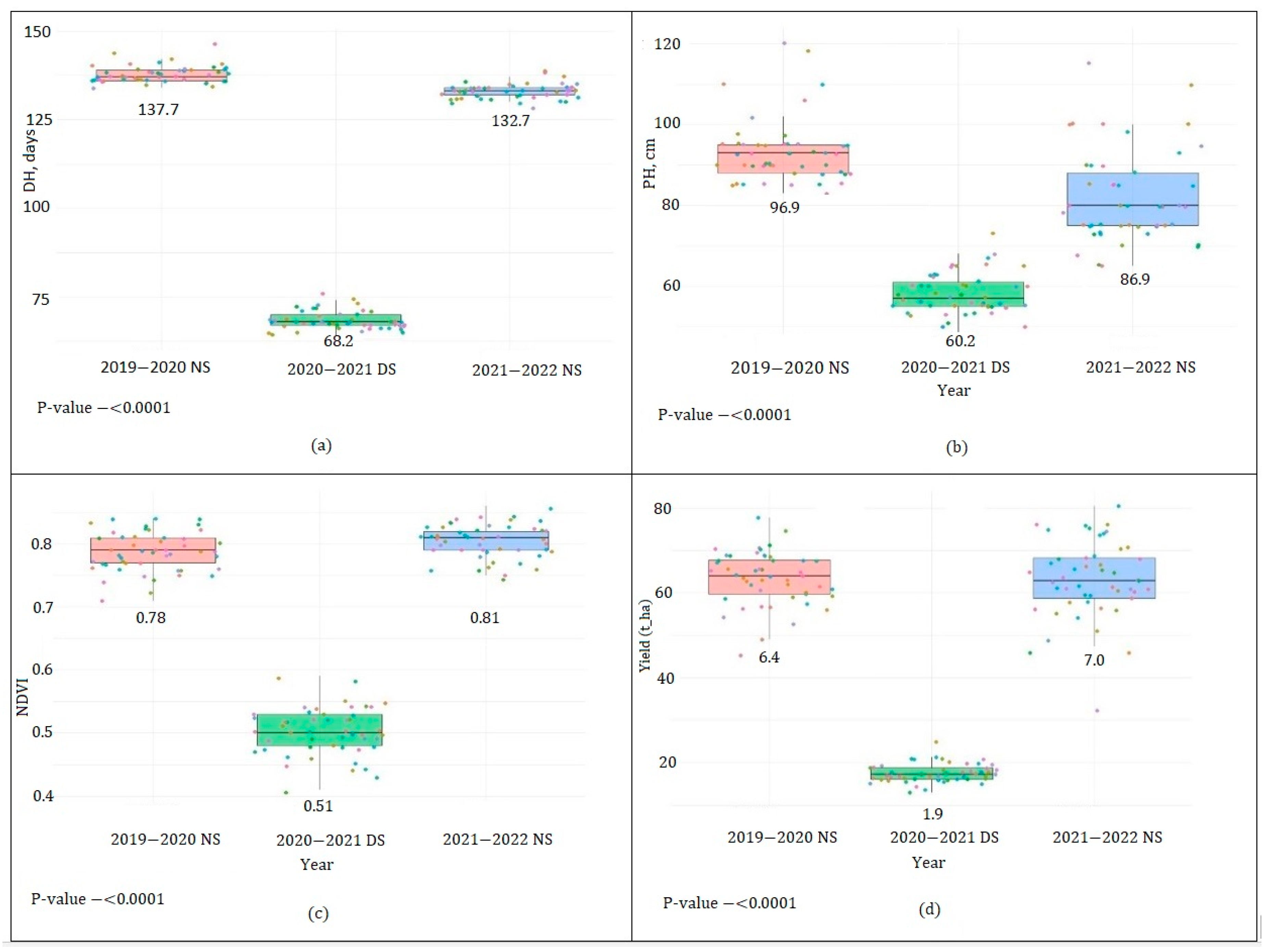1. Introduction
Agriculture is a strategically important sector of the economy, and its sustainability is directly dependent on climatic conditions. In an era of global climate change, food security is determined by the stability of crop yields. Climate shifts, accompanied by increasing water shortages and unpredictable droughts, threaten wheat production both globally and in arid regions [
1]. Predicting the potential impacts of drought on agricultural production plays a key role in ensuring food security. Several studies (Martre et al. [
2], Zhao et al. [
3], Graziani et al. [
4], Assen et al. [
5]) have shown that the projected 1 °C increase in global average surface temperature poses a serious threat to wheat production. Leng and Hall [
6] estimated that climate change could reduce global wheat yields by 12.3% by the end of the 21st century compared to historical levels.
Global climate change is characterized by a sustained trend of increasing average global surface air temperatures, leading to an increase in the frequency and intensity of extreme weather events. According to FAO data [
7], in 2022, the average annual temperature change in more than 128 countries exceeded the average values for the period from 1951 to 1980 by at least 1.0 °C. This is confirmed by the recorded temperature peaks of 2016 (+1.66 °C), 2020 (+1.71 °C), and 2021 (+1.44 °C), which indicate significant deviations from the long-term average values. Kazakhstan is located in the continental climate zone of the Asian region, where, according to climate forecasts by the Intergovernmental Panel on Climate Change, global temperatures could rise by 2.7–4.8 °C by 2100. In particular, in 2020, there was an increase in temperature from 0.76 °C in 2000 to 1.56 °C [
8]. The climate forecasts of the IPCC and FAO have been confirmed in Kazakhstan by climate studies for the period from 1950 to 2020. These studies have identified a high amplitude of temperature fluctuations (0.31 °C) and a negative trend in precipitation dynamics over most of the Republic during the summer (4–20% per decade) and autumn (2–20% per decade) periods. In this regard, one of the most relevant regional strategies for wheat adaptation in Kazakhstan is to increase the drought resistance of the crop [
9,
10].
The clearly evident trend of changes in temperature and precipitation, reduced soil moisture, and increased aridity invariably leads to changes in ecosystems. In this regard, one of the most pressing environmental problems for Kazakhstan, which has a negative impact on agriculture, is drought. Data from the FAO [
7], as well as studies conducted between 2000 and 2016 by Dubovik E. et al. [
11], showed that more than 50% of Kazakhstan’s territory experiences arid conditions, with the largest droughts occurring in 2012 and 2014. The observed climate changes have a negative impact on grain production in the Republic [
12,
13].
Winter wheat is an economically important cereal crop in Kazakhstan, accounting for about 20% of the national grain balance and cultivated on an area of over 600,000 hectares [
14]. According to data from Morgunov et al. [
15], the size of the area sown with this crop reached 14 million hectares in Western and Central Asia. Within Kazakhstan, the main crops were concentrated in the southern and southeastern regions, where winter wheat occupied up to 80% of the area designated for cereal crops in the region. The advantages of winter wheat over spring wheat are obvious and include a longer growing season, earlier maturity, and, as a result, more stable grain production. The effective use of autumn–winter moisture reserves, spring precipitation, and suitable temperature conditions contributes to yields that are usually 2–3 times higher than those of spring wheat [
16,
17]. However, in the arid climate typical of this region, winter wheat is also susceptible to stress factors. Studies of the climate of Kazakhstan for the period from 1941 to 2012, conducted by Salnikov and co-authors [
18], revealed a steady trend towards higher temperatures in the southern regions, as evidenced by high values of the determination coefficient (25–36%). An agroclimatic assessment based on moisture intensity and hydrothermal coefficient (HTC) indicators, conducted in 2015–2016 and taking into account climate change, classifies this zone as a “very arid warm” region [
19]. In this regard, forecasting the possible consequences of drought for agricultural production, in particular winter wheat, plays a key role in ensuring the country’s food security.
The complexity of assessing the impact of drought is due to its multifactorial nature, shaped by the complex interaction of various climatic variables, including precipitation, temperature, vapor pressure, and solar radiation.
Studies by Shirhorn et al. [
12] and Karatayev et al. [
9] assessed the impact of average temperature, heat, and precipitation on the yield and production of spring wheat in the arid conditions of Northern Kazakhstan, in particular, analyzing climate change covering the period from 1950 to 2020, drought conditions, and their impact.
For the winter wheat growing region (Southern and Southeastern Kazakhstan), which differs from the Northern steppe zones in terms of climate, soils, and crop production risks (wintering, frosts, snow cover, drought, and temperature extremes) [
20,
21], trends indicate a steady increase in air temperature. In particular, there was a linear increase in the average surface temperature from 0.25 °C to 0.40 °C per decade (with an increase of 0.25 °C in Almaty). The largest increase in the average surface air temperature was observed in spring (0.58 °C per decade); the smallest increase was observed in winter (0.07 °C per decade); and a steady increase was observed at a temperature of 0.20–0.21 °C per decade in summer and autumn (Karatayev et al.) [
9].
However, despite the importance of the southern and southeastern regions of Kazakhstan for winter wheat production (≥600 thousand hectares), scientific research that takes into account the specifics of the regional climate (significant daily temperature fluctuations) remains limited and insufficiently studied. The following aspects require clarification: how seasonal precipitation combines with temperature in different phases of winter wheat development; the impact of summer drought; in particular, the combined effect on crop yields of heat stress during the spring–summer period (especially in June–July) and moisture deficit, which are characteristic of the southeastern region of the country.
The aim of this study is to assess the variability of key morphophysiological characteristics and productivity of winter wheat accessions in Southeastern Kazakhstan during the growing seasons from 2019 to 2022 and to identify drought-resistant germplasm.
3. Results
3.1. Meteorological Observations
According to data from climate maps of the Republic of Kazakhstan [
31], which show the distribution of average annual temperature and precipitation, the southeastern and southern regions of Kazakhstan (Almaty, Zhambyl, and Turkestan) experienced average annual temperature variations from 7.0 to 13.0 °C (
Figure 1) and annual precipitation between 250 and 600 mm (
Figure 2) during the period from 1991 to 2020 [
35].
Analysis of the annual changes in temperature and moisture availability recorded by the meteorological station of “KazRIAPG” LLP during the research years (2019–2022) revealed significant positive deviations in ground-level temperature and precipitation amounts compared to long-term average values (
Table 3).
Analysis of the meteorological conditions during three growing seasons (2019–2021, 2021–2022, and 2022–2023) in terms of temperature and precipitation showed the following:
- (1)
The average annual temperature increased by +3.6 °C, which averaged +11.3 °C, with an average annual value in the zone of +7.6 °C;
- (2)
Annual precipitation exceeded the average by 148.8 mm (totaling 573.3 mm) compared to the average annual values (424.5 mm).
The agrometeorological conditions of the analyzed growing seasons were generally favorable in terms of temperature and precipitation for the growth and development of winter wheat but showed differences in their severity during the main periods of crop development (
Figure 3):
- (1)
Autumn (September–November)
The most favorable period for sowing and germination was the autumn of 2019, which was characterized by positive temperatures and sufficient rainfall. Autumn 2020 was characterized by a lack of moisture in the soil (−20.2 mm). In particular, 8.9 mm of precipitation fell in October, which, combined with elevated temperatures, led to a pronounced soil moisture deficit during the winter wheat sowing period. September 2021 was marked by high temperatures (+4.5 °C) and critically low precipitation (1.6 mm). Heavy precipitation in October–November 2021 was recorded against the backdrop of a significant decrease in the average daily temperature.
- (2)
Winter period (December–February)
The winter period was characterized by a relatively warm winter with low average monthly temperatures (−0.6 °C; −3.4 °C; +0.7 °C) compared to the average annual values of −7.8 °C; −10.8 °C; −8.3 °C, respectively. Uneven precipitation distribution was observed in December 2019, with rainfall reaching 1.7 times (50.1 mm) the average annual amount (29.1 mm), while December 2020 and 2021 experienced a moisture deficit of about half the average (14.1 and 14.0 mm, respectively). February was characterized by maximum precipitation levels, with 74.0 mm in 2020, 52.9 mm in 2021, and 33.9 mm in 2022, exceeding the average annual amounts by 3.4, 2.0, and 1.5 times, respectively.
- (3)
Spring period (March–May)
During the spring months, from March to May, there was a steady upward trend in positive temperatures, ranging from 6.4 °C to 18.7 °C (2020), from 4.1 °C to 19.4 °C (2021), and from 5.8 °C to 19.0 °C (2022). April 2020, March 2021, and March 2022 were characterized by heavy precipitation (2.5 times higher than normal). The maximum precipitation values for all years of research (168.6 and 145.4 mm, 3.0 and 2.5 times higher than the long-term average, respectively) were recorded in March and May 2022.
- (4)
Summer period (June–July)
In June 2020, temperatures and precipitation were below average. June 2021 was extremely dry (precipitation was half the average at 20.9 mm), with relatively high air temperatures. June 2022 was characterized by a steady increase in average daily temperatures (+3.1 °C), with precipitation levels low compared to the long-term average. The temperature regime and amount of precipitation in the first ten days of July, the month when winter wheat completes its growing season in Southern and Southeastern Kazakhstan, were close to the long-term average.
3.1.1. Standardized Precipitation Index SPI
Various indices are used to study the spatio-temporal patterns of drought periods, providing a more complete picture of drought dynamics and its impact on ecosystems [
11,
36,
37,
38,
39,
40,
41]. Currently, more than 70 countries around the world use developed SPI calculation programs to monitor drought. The calculated SPI values allow drought or waterlogging to be determined for different time scales. SPI indices calculated from monthly precipitation totals are the most informative indicators for diagnosing drought, as they reflect short-term moisture conditions, which in turn are key during the growing season of agricultural crops and correlate more strongly with atmospheric and soil types of droughts [
39,
42]. For the period from September 2019 to August 2022, an analysis of the annual moisture supply was conducted to determine the relationship between precipitation indicators and the SPI.
The climate aridity category for the analyzed growing seasons (2019–2022), calculated based on SPI values, is presented in
Table 4 according to the accepted classification.
According to the moisture index, the 2019–2020 growing season was generally favorable, although it was characterized by short periods of mild drought (SPI from −0.27 to −0.65). In 2020–2021, there was a negative precipitation trend (from −0.14 to −0.85), manifested in a mild but persistent and prolonged drought throughout almost the entire period. The downward trend in SPI values during the 2021–2022 growing season indicates an intensification of drought: the index values changed from −0.28 to −1.49, which corresponds to a transition from mild to moderate drought. Time series graphs were constructed to visualize the changes in monthly precipitation (
Figure 4).
Analysis of precipitation observation data with identical time scales showed a downward trend in precipitation during the periods studied. As can be seen in
Figure 4, there is a trend towards longer droughts lasting more than two months, especially in the summer and autumn months.
3.1.2. Hydrothermal Coefficient of G.T. Selyaninov (HTC)
The meteorological conditions of Southeastern Kazakhstan for the period from 2019 to 2022, assessed by the hydrothermal coefficient (HTC), are presented in
Table 5.
A comparative analysis of seasonal moisture values showed that the average HTC values for the first two autumn months (September, October) of the two vegetation periods studied (2020–2021; 2021–2022) were 0.3–0.17 and 0.02–1.2, which corresponds to the “very severe drought” category. This indicates that winter crops were sown in conditions of severe drought in the years under review. The winter and spring seasons of the years under study were less prone to drought due to relatively low atmospheric temperatures and sufficient precipitation. The summer months were subject to very significant meteorological droughts (0.42, 0.27, 0.28, respectively). Against the backdrop of high daytime temperatures and low rainfall during the summer, the intensity of the drought was characterized as a sustained severe drought.
3.1.3. Heat Stress
The increase in the frequency of droughts and heat stress has a direct impact on wheat yields. Wheat is sensitive to temperature conditions at different stages of development, with optimal temperature ranges for growth (16–22 °C), flowering (12–22 °C), and ripening (21–25 °C) [
43,
44,
45]. Meteorological conditions throughout the growing season have a significant impact on the formation of winter crop yields, with the most sensitive phases being heading and flowering as well as grain filling. Temperatures above 25 °C, especially during flowering and grain filling, can lead to heat stress, which disrupts the physiological processes of pollination and grain formation [
44,
46,
47,
48,
49,
50,
51].
Studies to determine the effect of heat stress temperature on the development of winter wheat plants were conducted during the heading and ripening phases based on a comparative analysis of the growing seasons of 2020–2021 and 2021–2022, which differed in terms of the temperature regime during the spring–summer period of crop development. The threshold value of heat stress temperature in the heading and ripening phases of winter wheat in the study was set at 25 °C.
Figure 5 shows the average temperatures and precipitation for the growing seasons of 2020–2021 (a) and 2021–2022 (b) from sowing to full ripening.
As can be seen in the graph (
Figure 5a), from the third decade of May to August 2021, there was an increase in temperature (from 19.4 to 26.9 °C). The recorded temperature peaks exceeding the heat stress threshold coincided with the period of plant heading and continued until the end of the growing season (maturation). A comparative analysis of the heading–maturation period in the 2022 season showed (
Figure 5b) a similar increase in the heat stress threshold temperature (from 19.0 to 26.5 °C). However, the difference in HDD (heat degree days, °C) between the two seasons during the heading periods was 12.8 °C (2021) and 4.9 °C (2022), and the stable trend of elevated temperatures in the 2021 season contributed to a high accumulation of HDD during the maturity period (34.2 °C) compared to 2022 (22.6 °C) (
Table 6).
3.2. Agronomic Traits
In the southeastern region of Kazakhstan, winter wheat ripens in May and matures in June–July. Analysis of average HTC values during the ripening period (May) in the seasons analyzed showed no drought (1.01; 1.03; 1.91, respectively), weak drought according to SPI in 2020 (−0.27), and mild and moderate moisture in May 2021 and 2022 (0.58; 1.18, respectively). The maturity period was accompanied by moderate and severe drought according to the HTC (0.2; 0.4), mild and moderate aridity according to the SPI in 2021 and 2022 (−0.18; −1.22), and mild and severe moisture conditions in 2020 (0.43–1.58).
To assess the impact of meteorological conditions on the economically valuable traits of winter wheat, the dynamics of changes in dependent variables of productivity (duration of the days to heading (DH); plant height (PH); NDVI vegetation index value and yield) were analyzed over three growing seasons (non-stress (2019–2020), drought stress (2020–2021), non-stress (2021–2022)), as shown in
Figure 6a–d.
Analysis of the dynamics of changes in biometric parameters revealed a sharp decrease in DH values, plant height, and yield in 2021 compared to 2020 and 2022 (
Table 7,
Figure 6). The results of the variance analysis revealed a statistically significant influence of the year on the agronomic characteristics of winter wheat (
p < 0.001), which indicates a significant dependence of crop productivity on the conditions of the growing season.
3.2.1. Days to Heading
The abnormal drought in October 2020 (8.9 mm), defined as a “severe drought” according to the HTC (0.17), and the dryness of the autumn–winter period of 2020–2021 according to the SPI (−0.38; −0.85), affected the germination of winter wheat crops. Sprouting was observed in March 2021, which naturally affected the duration of the period until heading (DH, 68.2 days,
Figure 6a), calculated from the emergence of shoots to 50.0–75% heading of the analyzed plots. In the relatively favorable growing seasons of 2019–2020 and 2021–2022, the DH was calculated in accordance with international practice from 1 January, resulting in 137.7 days (2020) and 132.7 days (2022), as shown in
Table 7.
3.2.2. Plant Height
In 2019–2020, the collection nursery was characterized by predominantly medium-sized plants. Plant height in the nursery varied between 83 and 100 cm. The extreme agrometeorological conditions of the dry 2020–2021 period had a significant impact on plant height (
Figure 6b). The average plant height was 68.2 cm (
Table 7), with a range from 51 to 71 cm among the nursery accessions. In 2021–2022, plant height values were close to those of 2019–2020. The heights of plants of the standard variety, STEKLOVIDNAYA 24, in the years analyzed were 115.0 cm (2020), 68.0 cm (2021), and 115.0 cm (2022), respectively.
3.2.3. NDVI
Studies conducted during the heading stage of plants revealed significant variability in the NDVI vegetation index in accessions of winter wheat from the collection nursery. The average NDVI values were 0.78 in 2019–2020, 0.51 in 2020–2021, and 0.81 in 2021–2022 (
Table 7). The decrease in NDVI values in the studied accessions during the 2020–2021 growing season demonstrated a statistically significant correlation between NDVI values and physiological parameters of plants, such as the duration of the period before heading, plant growth, and productivity during the analyzed growing season (
Figure 6c).
3.2.4. Yield
Analysis of the yield of winter wheat accessions under varying agrometeorological conditions in Southeastern Kazakhstan for the period from 2019 to 2022 revealed significant variability. A significant decrease in yield was recorded under conditions of moisture deficit in 2020–2021, with SPI at −0.02 and HTC at 0.21 (
Figure 6d). A 2–2.5-fold decrease in yield was observed in both the analyzed accessions and the commercial standard variety STEKLOVIDNAYA 24. The average yield in the nursery in a dry year was 1.9 t/ha, while in years with more favorable weather conditions, the yields were 6.4 t/ha and 7.0 t/ha, respectively (
Table 7).
3.3. Statistical Assessment of Economically Valuable Characteristics
Correlation analysis (
Table 8) revealed a strong positive correlation between the days to heading (DH) and plant height (correlation coefficient 0.84,
p-value < 0.0001), as well as between yield and NDVI (correlation coefficient 0.82,
p-value < 0.0001).
A positive correlation was observed between DH and NDVI (correlation coefficient 0.60, p-value < 0.01), as well as between DH and yield (correlation coefficient 0.56, p-value < 0.01). This indicates that accessions with longer days to heading (DH) tend to have higher NDVI values and higher yields. Moderate correlations were found between plant height and NDVI (correlation coefficient of 0.61, p-value < 0.01), as well as between plant height and yield (correlation coefficient of 0.55, p-value < 0.01).
The correlation coefficients between significant productivity variables (yield, DH, PH, and NDVI) were at confidence levels between 0.55 ** and 0.82 ***.
Assessment of the severity of economically valuable traits of winter wheat under conditions of no stress (NS, 2020) and drought (DS, 2021) revealed high sensitivity of the studied parameters to stress conditions (
Table 9). The drought resistance index (DI) values calculated for individual traits reflect the pronounced depressing effect of drought, with 0.63 (PH), 0.63 (NDVI), and 0.50 (DH). The combined effect of these factors under stressful conditions had a significant impact on plant productivity, as confirmed by a DI value of 0.27 for yield.
A comparative analysis of the yield of winter wheat nursery accessions revealed individual genotypes that exceeded the local check for productivity under drought conditions. In particular, three accessions demonstrated a significant (≥10%) increase in yield above the STEKLOVIDNAYA 24 check during the dry growing season of 2020–2021, including BONITO-37…, LYMARIVNA, and OK12D22004-016. In a dry year, the selected genotypes were characterized by early heading (DH of 66–69 days; nursery average of 68.2 days); resistance to lodging (plant height of 55–73 cm; nursery average of 60.2 cm), which indicates a rapid transition to the generative phase; and a balanced level of photosynthetic activity (NDVI of 0.56–0.59, nursery average of 0.51) (
Table 10).
Statistical analysis using the nonparametric Kruskal–Wallis test confirmed the presence of statistically significant differences in yield between the lines with promising productivity and the local check (
p-value < 0.05). The genotype BONITO-37/MV10-2000… (TCI, 22IWWYT-SA) accession demonstrated a yield of 2.5 t/ha under moisture deficit conditions in 2021, which is 31.6% higher than the yield of the check STEKLOVIDNAYA 24 variety (
Table 10).
For the genotype × environment analysis, the Eberhart and Russell stability model [
34] was used, which is still currently used for quantitative assessment of the ecological plasticity and stability of varieties for various traits, including yield [
52].
At the first stage, the environmental conditions were assessed using the environmental index (Ij). Positive environmental index values (1.60 and 1.46) were calculated for two growing seasons: 2019–2020 and 2021–2022, respectively. The dry growing season of 2020–2021, unfavorable for yield formation, had a negative environmental index value (Ij = −3.07). The “year” factor had the greatest influence on the variation in the “yield” trait (hx2 = 0.92). The “variety” factor had an insignificant effect (hx2 = 0.032). The “variety × year” interaction had a smaller effect, with an hx2 value of 0.015.
4. Discussion
According to the FAO [
3], Kazakhstan is among the top ten wheat producers in the world, with 17.5 million hectares in 2020, accounting for 4% of global exports. To ensure food security and breeding programs in Kazakhstan, it is critical to understand how climate variability affects wheat yields, particularly winter wheat grown in Southern and Southeastern Kazakhstan (≥600,000 ha). This crop is extremely vulnerable to climate variability, with increased temperatures and a shortened photoperiod.
Meteorological conditions during the growing season have a critical impact on the yield of winter crops. Analysis of meteorological conditions in Southeastern Kazakhstan in 2019–2022 confirmed the previously established [
19] steady trend of rising air temperatures. Average monthly temperatures exceeded long-term averages from (+2.9 °C) in 2020–2021 to (+4.6 °C) in 2021–2022, (+3.1 °C on average). The average monthly precipitation (574.2 mm) exceeded the long-term average by 149.7 mm.
The agrometeorological conditions of the analyzed growing seasons, which were generally favorable in terms of temperature and precipitation for the growth and development of winter wheat, showed differences in their severity during certain periods of crop development. HTC calculations showed that droughts in the area usually cover the summer and autumn seasons, last more than two months, and are persistent in nature.
The dry periods were characterized by atmospheric and soil drought, as well as elevated soil and air temperatures. Analysis of SPI values revealed short periods of mild drought (2020), sustained and prolonged drought (2021) throughout almost the entire period, and an intensification of drought from mild to moderate (2022). These results confirm the trend of decreasing precipitation in the summer and autumn months, as previously established by Karataev et al. [
9] in Kazakhstan.
The negative correlation between the frequency of drought periods and winter wheat yield, identified in a number of studies, indicates a statistically significant effect of the year on the structural components of yield [
53,
54,
55,
56,
57,
58,
59,
60]. Assessing the variability and drought tolerance of key agronomic and physiological traits of wheat and screening germplasm resources for higher drought tolerance and yield stability are prerequisites for developing new, better-adapted wheat varieties.
Screening of 45 winter wheat accessions from international variety trials for drought tolerance was conducted in Southeastern Kazakhstan, where soil and climatic conditions have historically been more favorable for breeding research to assess the potential productivity of winter wheat under drought conditions and resistance to lodging and fungal diseases.
The abnormal drought recorded in October 2020 (8.9 mm of precipitation) and classified as “severe” according to the Selianinov HTC (0.17), as well as the dry conditions of the autumn–winter period of 2020–2021 (SPI = −0.38; −0.85), had a negative impact on the germination of winter wheat and the length of the growing season, with a reduction in the maximum daily temperature (MDT) by half (from 137.7 to 68.2 days).
This led to a decrease in (a) plant height by more than 30.0 cm and (b) yield by 72.3%. Under the drought conditions of 2020–2021, a heat stress threshold temperature (>+25 °C) was established. The sustained increase in temperature was reflected in the high accumulation of heat degree days (34.2 °C HDD) during the maturity period, which had a direct impact on wheat yield.
Low drought index (DI) values also confirmed the pronounced depressing effect of drought: 0.63 (DI PH); 0.63 (DI NDVI); 0.50 (DI DH); 0.27 (DI Yield). The NDVI vegetation index, widely used to assess vegetation condition and predict crop yields [
61], also showed a decrease from 0.78 to 0.81 (2020, 2022) to 0.51 (2021), confirming the predictive value of NDVI, which is a sensitive indicator of plant response to agrometeorological conditions during a specific growing season. Strong positive correlations between the NDVI, growth indicators, and yield confirmed their value as stress indicators. This confirms that drought during critical phases of plant development significantly limits the realization of crop production potential.
For the genotype × environment analysis, the Eberhardt and Russell [
34] stability model was used, which is still used today to quantitatively assess the ecological plasticity and stability of varieties for various traits, including yield. For two climatically favorable growing seasons (2019–2020 and 2021–2022), the environmental index (Ij) was positive at +1.60 and +1.46, respectively.
The dry growing season of 2020–2021, which was unfavorable for yield formation, had a negative environmental index (Ij = −3.07). The factor “year” had the greatest effect on the variation in the “yield” trait (hx2 = 0.92). The “variety” factor had a negligible effect (hx2 = 0.032). The interaction between “variety × year” had a smaller effect, with an hx2 value of 0.015. By analyzing the correlation coefficients between these traits, the traits that had the most significant effect on grain yield were identified.
As a result of three years of research (2019–2022), under drought conditions during the 2020–2021 growing season with a high negative environmental index (Ij = −3.07), three adaptive genotypes were selected: (1) BONITO-37/MV10-2000… (22IWWYT-SA), (2) LYMARIVNA (23IWWYT-IRR), and (3) OK12D22004-016 (23IWWYT-IRR), with yields of 5.3, 5.6, and 5.2 t/ha, respectively. These yields exceeded the productivity standard of the commercial variety of local breeding STEKLOVIDNAYA 24 by 15.4 to 22.8%. The correlation coefficient between significant productivity variables (yield, DH, PH, NDVI) was at a confidence level of 0.55 ** to 0.82 ***.
Analysis of climatic data (temperature and moisture supply) in combination with the use of meteorological indices for environmental assessment (SPI, HTC), phenotyping of productivity traits (DH, PH, yield), inclusion of physiological assessments (NDVI), and statistical data processing (genotype–environment, correlation relationships) make this work valuable for future breeding research in the region.
The current study had some limitations, such as only three experimental seasons, diverse but limited germplasm (45 entries), and one location. However, overall, the three-year (2019–2022) screening of winter wheat germplasm from international variety trials in the drought-resistant conditions of Southeastern Kazakhstan confirms regional empirical data on how climate variability affects winter wheat productivity. An adapted (drought-tolerant) germplasm has been identified that can be used in future breeding efforts to create climate-resistant wheat. In the context of global warming, screening wheat for drought resistance is crucial to ensuring the country’s food security.
5. Conclusions
Analysis of meteorological conditions for three growing seasons (2019–2021; 2021–2022; 2022–2023) based on temperature conditions in the foothills of the Zailiyskiy Alatau (Southeastern Kazakhstan, geographical data) is consistent with long-term climate forecasts by the IPCC and FAO for the Asian region. According to the Inter-Governmental Panel on Climate Change, global temperatures could rise by 2.7–4.8 °C by 2100 [
8]. Regional climate trends from previous studies conducted in Kazakhstan for the period from 1950 to 2020 have also been confirmed [
9].
The data from these studies in 2019–2022 show a steady increase in (1) the average annual temperature by +3.6 °C (+11.3 °C), with an average annual value in the zone of 7.6 °C, and (2) the total annual precipitation, which averaged 573.3 mm (average annual value of 424.5 mm). A comparison of SPI indices and HTC values for the period from 2019 to 2022 showed that both indicators demonstrated acceptable results when assessing climatic conditions in terms of moisture.
The data obtained indicate a prolonged drought period in the region, with the most pronounced manifestations in the autumn–winter and summer–autumn months. A comparison of temperature regimes during the “heading–ripening” period revealed that under the extreme vegetation conditions of 2020–2021, heat stress affected winter wheat throughout the entire period, whereas during the favorable vegetation period from 2021 to 2022, it affected only the ripening phase. A statistically significant influence of the year factor on the economically valuable traits of winter wheat was revealed (p < 0.001). A 3.4–3.7-fold decrease in yield under extreme conditions was noted, confirmed by the drought resistance index (0.27).
During the drought of 2020–2021, three adaptive genotypes were selected that exceeded the standard productivity by more than 10%. After three years of research, the drought-resistant accession BONITO-37/MV10-2000… (22IWWYT-SA) was selected, exceeding the yield (up to 31.6%) of the local commercial variety STEKLOVIDNAYA 24. This promising accession has been included in the breeding program of the Ministry of Agriculture of the Republic of Kazakhstan, “IRN BR24892821, Breeding and primary seed production of grain crops to increase the potential for productivity, quality, and stress resistance in various soil and climatic zones of Kazakhstan” for 2024–2026.
The information obtained as a result of the studies (1) confirms previously obtained data [
16] on a steady trend towards rising temperatures in the southern regions of Kazakhstan, which classify this zone as a “very arid warm” region; (2) enables more accurate forecasting of the consequences of drought for agricultural production of important grain crops in Southeastern Kazakhstan, in particular, winter wheat in the foothills of the Zailiyskiy Alatau; and (3) improves the level of pre-breeding and breeding programs for winter wheat by the Ministry of Agriculture of Kazakhstan by including productive sources of drought resistance with early heading, resistance to lodging, and balanced levels of photosynthetic activity (NDVI 0.56–0.59), which indicates a rapid transition to a generative phase for the creation of climate-adapted varieties.
